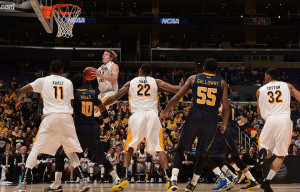The History of Wichita St. Basketball
As one of the stories of the year, the Wichita State Shockers have gone undefeated in the regular season of their college basketball season. After making it to the Final Four the NCAA Men’s Basketball Tournament last year and earning a record of 34-0 this season, the Wichita St. basketball team is now where they have rarely been—in the limelight of sports prominence. For the casual sports fan, the Shockers have not often come to mind when it comes to choosing a winner for their March Madness brackets. However, Wichita St. basketball has come a long way since its beginning, starting under the name Fairmount College.
The Beginning of Shockers Basketball
Under the original name of the “Wheatshockers”, the Fairmount College basketball team competed in its first season in 1906. Head coach Willis Bates and his six players finished the season 2-4. You don’t need medical translation to know that going 2-4 isn’t the best start to a program, but Fairmount College would eventually make strides forward, including the development of the full-court zone press under Coach Gene Johnson.
[poll id=”264″]
Start of Success
The Shockers would begin to see success after joining the Missouri Valley Conference, when the school hired Ralph Miller from East High in 1951. Miller convinced his star player in high school, Cleo Littleton, to come with him to the college. Littleton became one of the first African-American players in the Missouri Valley Conference. He was also the first to score 19 points per game as a freshman—a school record that stands today. Under Miller in the 1964, Dave Stallworth would become the Shockers’ first consensus all-American, scoring a career average 24.2 points per game. Miller would later be inducted into Naismith Basketball Hall of Fame after building the Shockers’ basketball program.
Wichita State’s First Great Season
In the season following the school’s induction into the state university system as Wichita State University, the Shockers would go 19-7 and win the Missouri Valley Conference in the 1964-65 season under Gary Thompson. In the NCAA tournament of that season, Wichita St. would defeat SMU and Oklahoma St. in order to earn a berth into the Final Four—an accomplishment tied for the school’s deepest-ever run in the tournament. In their Final Four matchup, Wichita St. would lose to defending national champs UCLA Bruins by a score of 108-89.
One More Run Before Insignificance
11 years after Wichita St.’s greatest season at that point, the Shockers would win their next Missouri Valley Conference title. With one of the school’s best-assembled teams, including freshman-phenom Cheese Johnson, the 1975-76 Shockers returned to the NCAA tournament. A heart-breaking loss by one point to Michigan—the eventual runners-up—in the first game of the tournament would then be followed by the Shockers’ Elite 8 season in 1981 in which Wichita St. defeated Kansas. The Shockers would subsequently go through a period of mediocrity through the 1990s.
Return of the Shockers
Under new Athletic Director Jim Schaus, Wichita St. would begin to see success again in the 2000s. The hiring of coach Mark Turgeon would prove advantageous as he brought the team to three consecutive 20-win seasons and the school’s first conference championship in 23 years. The program has continued to gain momentum as the Shockers won the NIT tournament in 2011 and reached the Final Four of the NCAA tournament last season. Now, Wichita St. is poised to make a deep run in the tournament with the likelihood of a one seed and the confidence that only an undefeated season can give you.

This post has a good story of the Wichita St. Basketball. Basketball is my favorite and every sports game is the help for fitness to health. This is especially with the boys who are in institute and their parents are nowhere to be found so as to assist with the office work.
software localization involves separate and distinct workflows for the adaptation of the user-interface, help files, and technical documentation. However, these separate processes must be coordinated and leveraged in order to ensure the maximum cost savings, fastest time-to-market, and greatest consistency in the final product.